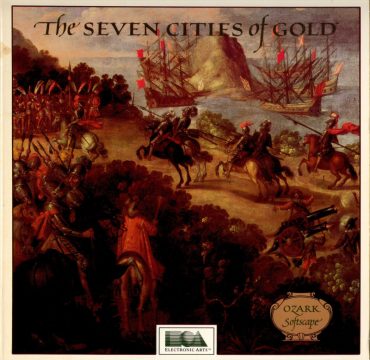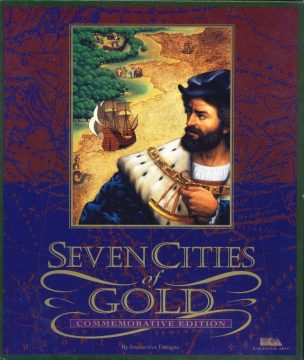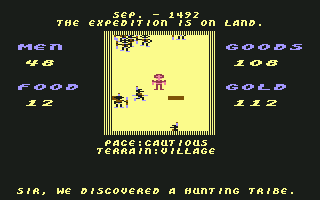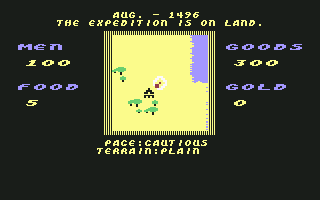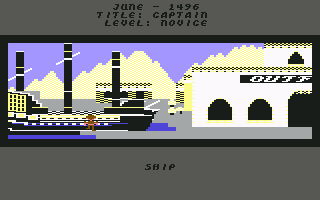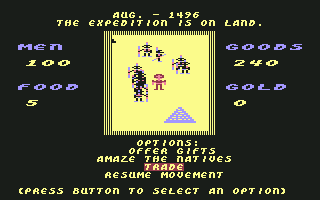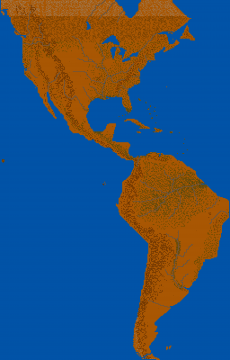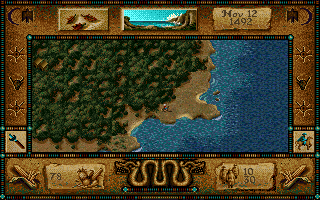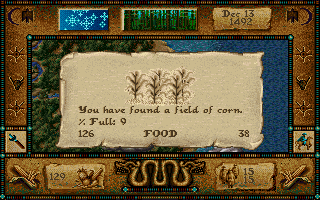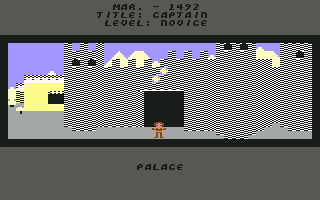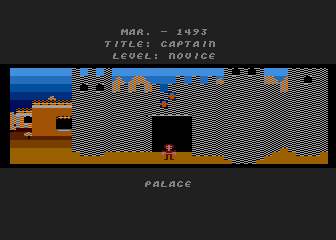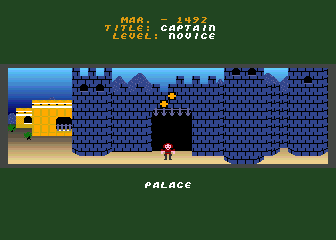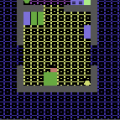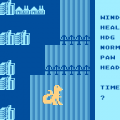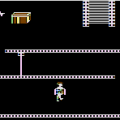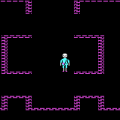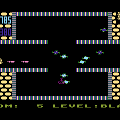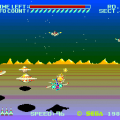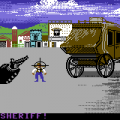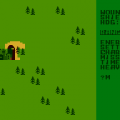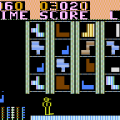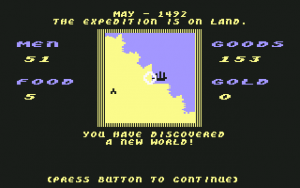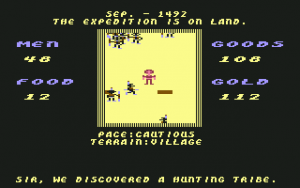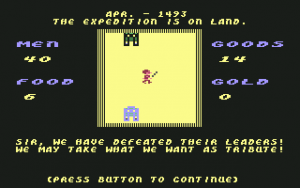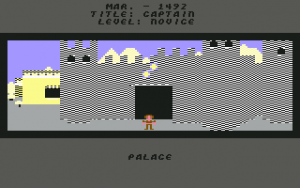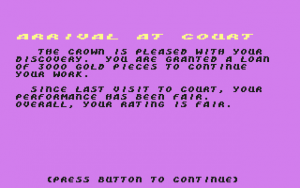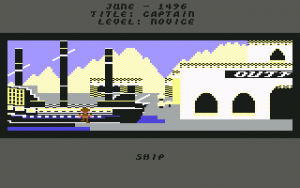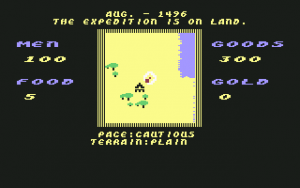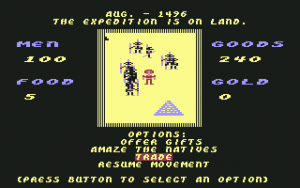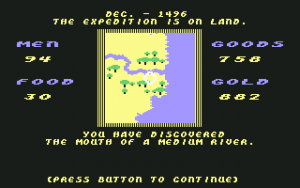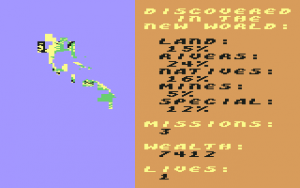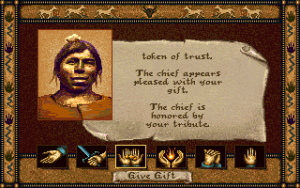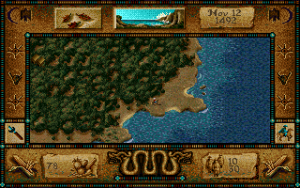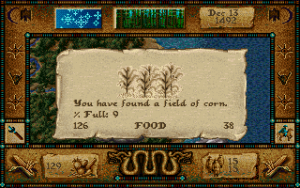- Seven Cities of Gold, The
- Heart of Africa
Danielle Berry (Dan Bunten at the time of the game’s development) was one of the most notable home computer game designers in the 1980s and early 1990s. Her games were usually fairly complex (at least for their time) strategy games with a strong focus on economy and resource management. Most of those titles, of which the most known one today will be M.U.L.E., were mainly competitive multiplayer games – local at first, later (starting with the release of Modem Wars in 1988!) designed specifically for online gameplay.
Originally, Seven Cities of Gold was also supposed to be a multiplayer game. The opponents would first take turns exploring the New World, then set up and try to maintain permanent colonies (like in the board game Conquistador, a major inspiration for the game) before finally fighting each other for territory. After a few brainstorming sessions at Ozark Softscape, it was decided that writing such a game would not be feasible and the scope of Seven Cities was reduced: war and diplomacy got thrown out completely, colonization was reduced to a bare minimum and the game became a single player only experience. Given how complex the finished product is, it becomes quite apparent that no amount of optimization deep magic would have allowed Ozark to create a game that is as deep as Seven Cities of Gold and at the same time three times larger and multiplayer.
Seven Cities quickly became Ozark Software’s best-selling game. While today it seems overshadowed by her multiplayer efforts, one shouldn’t assume it’s somehow worse or less important than those games. The game’s influence can be seen in Sid Meier’s Pirates and (obviously) Colonization and, more generally (and probably indirectly), in the ‘eXplore’ part of the 4X strategy genre. Additionally, while Seven Cities was not the first game with procedurally generated maps, its generator is probably the first one to create maps that actually make sense by taking account of realistic factors like climate and plate tectonics.
Seven Cities of Gold can be played on a historical map of the Americas (with nearby islands) or a randomly generated one (to illustrate how ahead of its time the algorithm was: creating a random map requires another disk and can take up to 15 minutes, depending on the computer).
Regardless of the map choice, the player starts the game in Spain after being granted a few ships with crew and equipment by the royal family, as well as some gold for additional purchases. This all happens in a city rendered from side view (with nice parallax scrolling) which really highlights how far removed this place is from the rest of the game: not only does it look and control differently, it’s also the only real safe spot, the only place where you don’t have to consume food and the only place that lets you save. Yes, while modern games usually either save automatically or let you save anywhere, in Seven Cities of Gold you’re forced to sail back across the Atlantic first.
After the preparations, the player character boards the ship and the actual game begins. From now on, the game is played from a top-down perspective and the player is represented by a compass icon. Travel across the ocean is generally slow and often uneventful (aside from avoiding an occasional storm cloud). The player even has the option to set a course and leave the ship on ‘autopliot’. After finally arriving in America (where exactly is up to you, although new players usually go straight west from Spain), it’s possible to drop some men off the ship, give them supplies and explore the land.
There are no set goals in Seven Cities of Gold. The royal family wants the player to bring back as much gold as possible, which is rewarded with a better title and even more gold for buying ships and supplies, but there is no penalty for ignoring them. The game keeps track of missions you’ve set up (usually by conquering a native village, although it can be done peacefully) but there is neither a reward for doing it nor a punishment for refusing to do so.
The real point of the game is exploration of its large and surprisingly diverse world, adding little by little to the map that is viewable at your home in Spain. Seven Cities of Gold is all about discovery: there’s even congratulatory music played every time you reach a source or a mouth of a river or discover an interesting region (mountain ranges, jungles, plains etc.). It may sound quite tedious and boring, but it actually manages to capture the fear and excitement of trekking through a dangerous foreign land. The game world is large, but never empty or repetitive.
That is not to say that Seven Cities of Gold is just sailing and walking – it’s an important part for sure (and a fairly complex one – from the colors of the trees in moderate climate areas changing with seasons to the fact that you move at different rates across different terrain), but no game about conquistadors would be complete without interacting with the natives. While moving through America, you’ll often come across different villages and cities inhabited by various Native American tribes (unfortunately, the only named ones are Aztec and Inca). The settlements have different cultures and levels of technological advancement, which affects trade items and combat strength in the event of an attack. Upon entering a town, a group of people gathers around your character, making movement difficult. You can distract them with gifts or magic tricks to make your way to the chief and initiate trade, but you need to be careful – bumping into other characters kills them and if you kill too many (or kill the chief), everyone else becomes hostile. This sometimes frustrating behavior is quite intentional – it’s an abstract way of showing conflicts created by communication problems due to lack of common language.
On the other hand, you can simply go into every native town with your sword drawn and kill everything that moves (although killing the chief first may be a better idea as it means the battle will be over quickly). The conquistadors are much better equipped than the natives, so the battles aren’t too hard and winning them allows you to easily set up missions (you need many gifts to do it peacefully) and take all the gold and food without trading. It increases your chances of getting ambushed and it can make nearby villages of the same culture hostile but that’s not a big deal given how easy the combat is. It’s an ethical dilemma – conquest is easier, but it’s simply not a good thing to do. There is no karma meter and no punishment (the king might criticize you but he’ll still give you money and titles if you bring gold) – the game expects you to know that indiscriminate slaughter is wrong, it’s not interested in heavy-handed moralizing.
Despite the easy combat, Seven Cities of Gold can be quite a difficult game. The real challenge lies in resource management – your men need to eat, you need to bring goods for trading and you’ll want to come back with gold. Even if you don’t care about the king’s opinion, you’ll need to buy more food and hire men to replace the ones that died. The ships have a limited carrying capacity, but it’s much greater than that of on-foot expeditions. This sometimes creates interesting situations. For example, you might be far away from your ship without goods, low on food and close to a small village. Do you risk starvation while walking all the way back or do you rob the villagers?
Unfortunately, more often than not the campaign is much more monotonous: you’ll just go back and forth between undiscovered areas, a ship and the nearest mission until you need to return to Spain either due to a food shortage or ships not being able to carry any more gold.
Despite the title, there is only one city of gold to be found on the game’s historical map. It’s hidden pretty well, is marked as a mountain before you visit it and disappears when you leave. It’s possible for the generator to create more of those ‘lost cities’ and they always look like mountains, but it’s not like you’ll need to walk over every possible mountain if you’re playing on a random map. The city is usually generated outside of the mountain ranges – if you see a mountain in the middle of a plain, it’s probably it.
Historical map from the Atari version (extracted with Kroah’s 7CoG map viewer)
Seven Cities of Gold was ported to many different 8- and 16-bit microcomputers. Berry called the Atari version the only “full” version among the 8-bit ports Ozark Software did, but the Commodore 64 version seems quite faithful to the original. It might be missing something not immediately visible to the player – maybe some advanced parts of the map generator or native behavior script. The changes become apparent when you boot up the Apple II version. It not only looks much worse than the original, it lacks some of the cooler effects like the quill writing the game’s title in the intro or the trees changing color with the seasons. Of the 16-bit ports, anything other than the Amiga version (which improves graphics a bit but otherwise plays just like the 8-bit game) seems to have disappeared into obscurity. Some screenshots of the bootable IBM PC game can be found, but no disks for sale or dumps seem to exist. The Macintosh version is even harder to find as there aren’t even screenshots available anywhere.
Another IBM PC version was released in 1993 as Seven Cities of Gold: Commemorative Edition. This time, the game was remade completely. The graphics are obviously better and the game actually has background music now (in the original there was none outside of the intro tune and the sound of drums which could be heard in native villages and got progressively faster if you made the inhabitants angry). The resources are now divided into food, plants, animals and arms and you need to figure out which native tribes are interested in which. You can also bring different valuables from the New World: plants, spices, artifacts and gold. Your crew will now consist of explorers (uncover more area on the map), soldiers (fight better) and clergy (required for setting up missions). They can travel faster if they bring enough horses. The combat was made more difficult and the king now cares more about colonization than about gold. Also, there are more things to be found on the map: corn fields, gold, burial mounds (which are better left alone unless you want to make everyone hate you).
Unfortunately, most of the changes in the remake are not for the better. Horses and animals take a lot of space on your ships and you need them for travel and trading. You also find less gold (especially given that it’s now much harder to just kill everyone and steal as much as you can carry) which means that you have to rely more on the royal family’s loans – and to do that, you not only need to set up colonies but also bring them food as they don’t seem to be able to sustain themselves. As a result, the game becomes much more restrictive than the original. It also seems unfinished – there are no visible effects of season change on the map (something they managed do on the Atari in 1984), entering the villages always teleports you to a green forest (even if you’re in Mexico) and while natives wear different headgear and their chiefs have different portraits, the sprites are otherwise almost identical – up to everyone regardless of culture or geographical location fighting with tomahawks. Most annoyingly, there are either no cities of gold in the remake or they are hidden so well that nobody managed to find them since 1993.
The original Seven Cities of Gold is a remarkable game. It’s not without flaws – the graphics are dated and the resource management can get tedious, but it’s a deep, rewarding experience while at the same time much more approachable than many similar 1980s home computer games. The remake has some interesting ideas behind it, but is ultimately too restrictive and doesn’t manage to capture the feeling of adventure as well as the 1984 game. Some of it comes down to minor details – the change of seasons, the fanfare you hear when you discover something. But it’s those details that make the world seem alive and believable, and that was the most unique and important part of Seven Cities of Gold.
Links:
Seven Cities of Gold at The Digital Antiquarian
Scans of the original manual at Atarimania
Interview with Danielle Berry
Seven Cities of Gold: Commemorative Edition on GOG.com
Screenshot Comparisons

